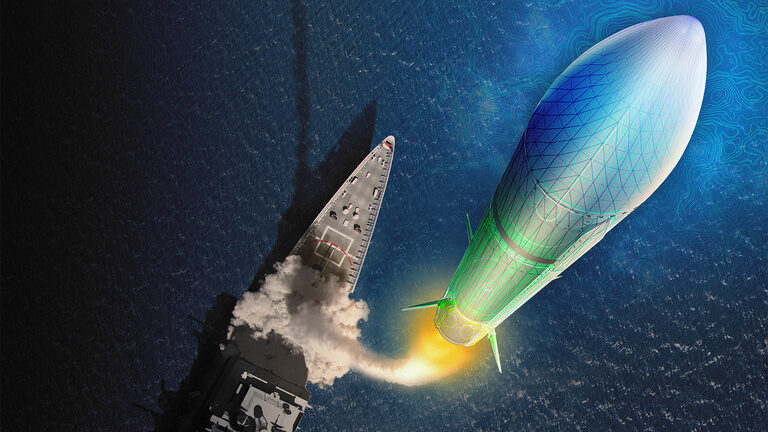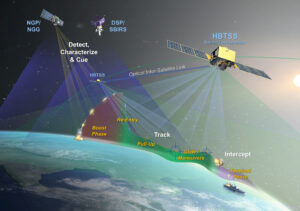
Raytheon artistic rendering of a GPI conceptual design. (Raytheon illustration)
Update Nov. 22, 2021 at 3:00 p.m. ET: This story has been updated to add comment from Lockheed Martin.
WASHINGTON: The Missile Defense Agency has tapped Raytheon, Lockheed Martin and Northrop Grumman to compete in developing a new Glide Phase Interceptor (GPI), a defensive hypersonic weapon designed to take out adversary hypersonic missiles midcourse during their unpowered flight.
Raytheon Missiles and Defense was awarded $20.97 million; Lockheed Martin, $20.94 million; and Northrop Grumman, $18.95 million, according to MDA’s contract announcement today. Concept designs for prototypes from each vendor are due by September 2022.
MDA’s May 19 Broad Agency Announcement for GPI set an original timeline for awards as this summer, but discussions on the complex technical issues took longer than anticipated.
“Multiple awards allow us to execute a risk reduction phase to explore industry concepts and maximize the benefits of a competitive environment to demonstrate the most effective and reliable Glide Phase Interceptor for regional hypersonic defense, as soon as possible,” said Rear Adm. Tom Druggan, MDA’s Sea-based Weapon Systems program executive.

The Hypersonic and Ballistic Tracking Space Sensor would track hypersonic missiles in during their glide phase. (Northrop Grumman)
The GPI is being developed to knock down hypersonic missiles as they glide through the Earth’s upper atmosphere at about 70 kilometers in altitude at speeds greater than Mach 5. It is being designed for launch from the Navy’s Aegis cruisers.
Today’s ballistic missile systems, both for tracking and targeting, were optimized for just that: a ballistic missile taking a highly arched trajectory in which most of its flight path is in outer space. Hypersonic missiles spend little if any time in space and further can maneuver so that their paths are unpredictable. Speed plus maneuverability means they are extremely difficult to track.
The radar on the Navy’s Aegis ships and the Sea-Based X-band Radar used for terminal defense (i.e. as the missile is getting close to its target) can track hypersonic missiles, but of course that depends being in the right place at the right time.
For this reason, MDA and the Space Development Agency are developing the Hypersonic and Ballistic Tracking Space Sensor (HBTSS) satellites in Low Earth Orbit (between about 100 kilometers and 2,000 kilometers up) to augment current missile warning/tracking satellites that lose hypersonic missiles after their boost phase. Northrop Grumman is also on contract for an HBTSS sensor, competing with L3Harris.
Further, the Aegis Ballistic Missile Defense system’s SM-3 interceptor is designed to kill an incoming missile in space — as is the Army’s Ground-Based Interceptor on the Ground-based Midcourse Defense system. The range of the Navy’s terminal-phase interceptor, the SM-6, is just too short given the high speeds of hypersonic weapons; the range of the Army’s Theater High Altitude Area Defense (THAAD) is even shorter.
GPI aims fill that gap, with MDA already considering how the interceptor might be fitted to land-based missile defense systems.
“GPI will be the first-ever interceptor with the speed, ability to withstand heat and maneuverability required to intercept hypersonic threats in this environment,” Tay Fitzgerald, vice president of Strategic Missile Defense at Raytheon Missiles & Defense, told Breaking Defense in an email. “As we develop GPI, we are applying data from our hypersonic strike weapons currently in development to help accelerate the program.”
“GPI leverages our proven success in developing and fielding the Terminal High Altitude Area Defense, or THAAD, weapon system. This, combined with our Aegis weapon system expertise and knowledge, affords us the unique capability to support the hypersonic threat for MDA,” said Julie Pecson, program director of the Glide Phase Interceptor program at Lockheed Martin, in an email.
Space Force EW unit working to integrate new weapon systems, intel personnel
The Space Force’s Delta 3 is responsible for organizing, training and equipping Guardians for electronic warfare missions involving satellite communications, as well as sustaining related offensive and defensive EW systems.



























